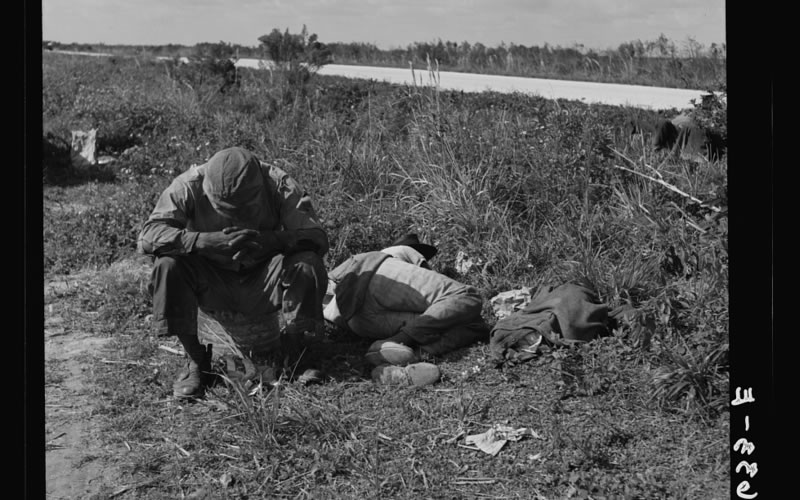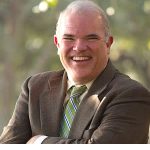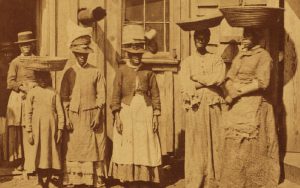
Depression-era photographer Marion Post Wolcott snapped this image in 1939 of tomato pickers on their lunch break in a field near Homestead, Fla. Charleston County once was home to a huge truck farming industry, which included tomatoes that were shipped to northern markets. Photo from the Library of Congress.
[Editor’s Note: West Ashley resident, Realtor and county planning commissioner Charlie Smith offered a 1,700-word essay last week to Facebook friends that showcased how Charleston can confront and embrace its past and move forward. While you can find the whole essay here, we offer this excerpt to jumpstart a serious community discussion that bridges the past and future.]
By Charlie Smith, Special to Charleston Currents | When the Charleston County Planning Commission’s subcommittee on historic preservation announced last year that consultants had been hired to conduct the 2016 update of the Historic Resources Survey, I was initially very excited that we would finally be addressing some of our past failures to protect important historic sites and buildings throughout Charleston County.
Realizing that we did not have endless funds with which to work, we began to narrow the scope to a task that was feasible given our limited resources. I was initially not happy at all with the 1940-1975 time frame chosen for the limited study.
Charleston has a deeply-rooted complicity at every level in the atrocious politics of skin color — from the kidnapping and monetization of abducted human beings, to the forced labor, to the abandonment after emancipation and, finally, to the corruption of the political system to prevent formerly enslaved people from realizing the freedoms they had been promised. [I felt] we must come back to this task, we must record the history and we must get it right this time!

Smith
So you may wonder with my interest in Reconstruction politics what changed my mind about the 1940-1975 scope of work that was adopted by the Charleston County Planning Commission being the correct time frame for this study. One public meeting made the difference. This past Wednesday evening, the commission’s Subcommittee on Historic Preservation held a public workshop to discuss the findings of the Historic Resources Survey of unincorporated Charleston County. At that meeting, something astounding happened. As it turns out, many of us, including myself, had assumed that the untold history of the West Ashley area was the “big story” that had consistently been omitted from prior historic surveys of Charleston County. We were not wrong, but Wednesday’s meeting made it clear that there had been MANY MORE important omissions that had been deleted from Charleston’s history over the same period in time.
As people lined up at the door to get in, I noticed something interesting. The vast majority of those present were descendants of those who had been robbed of their freedom a second time by South Carolina’s Reconstruction politics in the 19th century and who had been relegated to eking out an existence tied around the waist underwater with ropes digging phosphate rock off the bottoms of our river beds or living in extreme poverty as sharecroppers on plantations turned truck farms with little hope of any financial or political gain.
That’s when I realized that the people who were in that room Wednesday night WERE the history. They are, in fact, the only ones left with the ability to truthfully tell the story of what happened to the thousands of Charleston families who have been consistently omitted from our history since emancipation.
Once I came to that realization, it was clear to me that limiting the scope of our study to the period between 1940 and 1975 was exactly the right thing to do. We no longer have the ability to record firsthand stories of reconstruction, the phosphate mining period or the early days of truck farming because those people are all gone. But we can accurately record the history of this period with firsthand information if we focus on 1940 to 1975. All we have to do is to start talking to each other. Now.

From a stereoscopic image of oyster and fish women in Charleston from 1870 by photographer B.W. Kilburn. Photo is part of The New York Public Library Digital Collections.
We have a chance to record all the stories that still exist, even if they still exist only in the minds of those whom we hope will convey them to us. But these conversations need to be in a “new language” that is respectful, truthful, employed as resolution and, maybe if we are lucky, employed with a little absolution for the families of those who feel as I do about my own family — that my own people were complicit in creating the current situation by their past racist actions toward others who were powerless. As with any “new language,” its mastery requires practice so that the truth can be told and history can be accurately recorded. If we start practicing now, we will have some fascinating stories to tell future generations. The important thing to remember in this is that no matter how we got here, here we are! We cannot fix the past, but we have an absolute obligation to future generations to be honest about the past as we retell the stories in our lifetimes.
As we begin to talk about the 1940-1975 time frame of our shared history, we must address the uncomfortable subjects and painful actions endured by people of color in our community –people we knew, people we were often times even related to.
- We must tell the story of the obliteration of the entire neighborhood of Middlesex for the construction of the Gaillard Auditorium.
- We must be honest about the 1,100 homes that were destroyed by the Gaillard administration in the mid-1960s and never replaced.
- We must know how the Gaillard administration’s “Workable Program” projects created many of the problems faced by the City of North Charleston, a jurisdiction that was created partly in reaction to “refugees” displaced by the construction of the Crosstown Expressway, The Gaillard Auditorium and the I-26 projects.
- People must know that the neighborhood destroyed by the Crosstown was the power base of Charleston’s African American community. The location of that project was NOT arbitrary.
- We also need to be honest about the role that racism played in the founding of the Town of James Island.
- We need to know more about the family ties between sharecroppers on James Island and the millworkers in Patchogue, Long Island, N.Y., and why black families left James Island to work in a lace mill in New York when we had textile mills by the dozen in our own state who would not employ them.
In short, we all need to talk about our history from 1940 to 1975 while it is still alive and well in the minds of those who lived it. And then we need to write it down truthfully and employ it as an impenetrable roadblock so that as Charlestonians, we never choose the road to exclusion again.
- Have a comment? Send to: editor@charlestoncurrents.com



 We Can Do Better, South Carolina!
We Can Do Better, South Carolina!

























One Comment